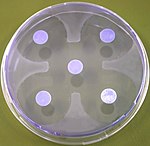Microbial Screening
Microbial screening is used, among other things, in the food industry or food analysis, for example to examine the starting materials for a food for harmful residues. Routine z. B. meat, egg or dairy products examined for residues of antibiotics. So-called microbial inhibitor tests are used to detect antibiotics. These test systems are based on the metabolic activity of selected bacteria (e.g. Geobacillus stearothermophilus var. Calidolactis ) or on the inactivation of these. A large number of different test methods exist around the world, two of which are presented here.
Selected test procedures
Bacterial Reduction Tests (BRTs)
In the so-called BRTs, the spores of the test organisms are added to a specific nutrient medium that is provided with a special dye (e.g. bromocresol purple ). This dye is enzymatically split by the bacteria during incubation at 64 ° C ( Geobacillus stearothermophilus var. Calidolactis ) within about three hours and changes its color from blue to yellow. If a liquid food sample (e.g. milk) that is contaminated with antibiotic residues is placed on the culture medium before incubation, the bacteria are killed or strongly inhibited and there is no or only an incomplete change in color. In such a case, the sample is to be regarded as containing inhibitors and a detailed chemical analysis is (usually) carried out to determine which antibiotic the sample contains and whether its concentration exceeds the legal limit.
Agar diffusion tests
In this test procedure, the nutrient medium mixed with the spores of the test bacterium (e.g. Bacillus subtilis ) is poured into Petri dishes while still warm, where it hardens to a clear, jelly-like mass within minutes. Then cellulose sheets with a diameter of 12.7 mm soaked with the sample liquid are placed on the nutrient medium (usually 3–5 pieces). Incubation takes place at approx. 37 ° C for 5–10 hours. The bacteria that multiply during this time completely cloud the previously clear culture medium. However, if there is an inhibitor in the sample liquid , e.g. B. an antibiotic, depending on the active ingredient and concentration, a more or less large halo forms around the cellulose leaf. This halo is a kind of death zone, in which the antibiotic leaking from the test paper is effective and kills the bacteria. By killing the bacteria, the culture medium is not clouded at this point. Similar to the BRTs mentioned above, this method only provides an indication of the presence or absence of inhibitors.
Summary
Microbial test systems have the advantage of being very cost-efficient (the above-mentioned test procedure costs around 1–2 euros per test) and of delivering a result within a very short time. The large number of different antibiotics has a disadvantageous effect, since not every test organism reacts equally sensitively to different inhibitors and very small concentrations often cannot be detected. The existing test systems must therefore be continuously improved in order to guarantee seamless food monitoring.
Detection limits of microbial screening methods for some antibiotics
- Tetracycline HCl : Approx. 100 µg / l
- Penicillin G : Approx. 2-3 µg / l
- Chloramphenicol : Approx. 2500 µg / l
- Erythromycin : Approx. 50 µg / l
